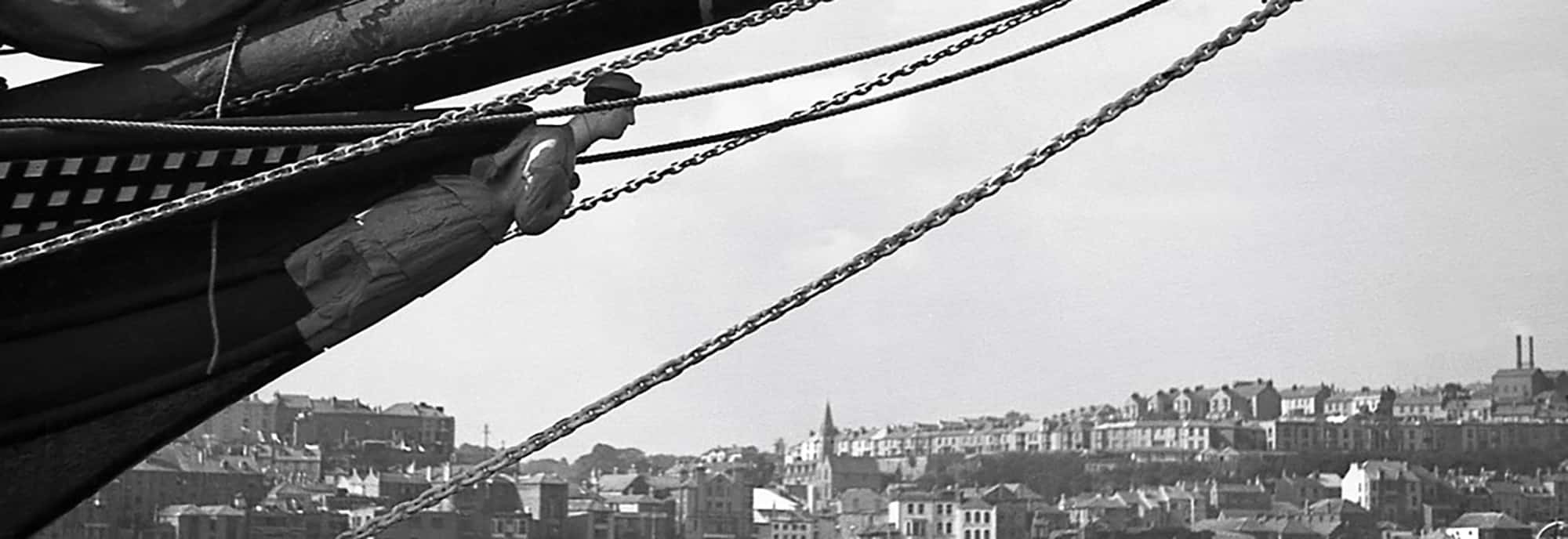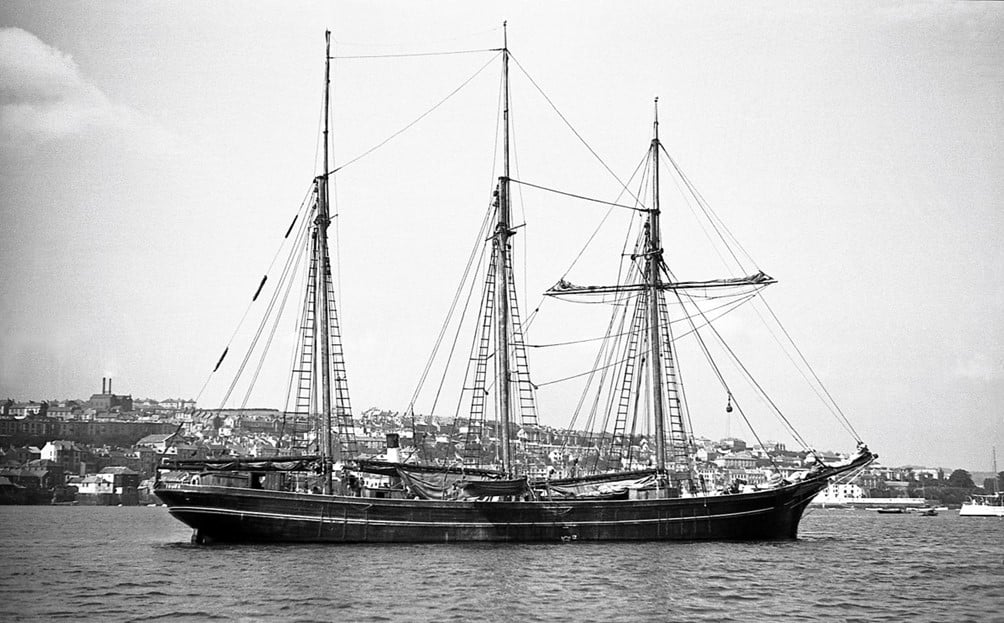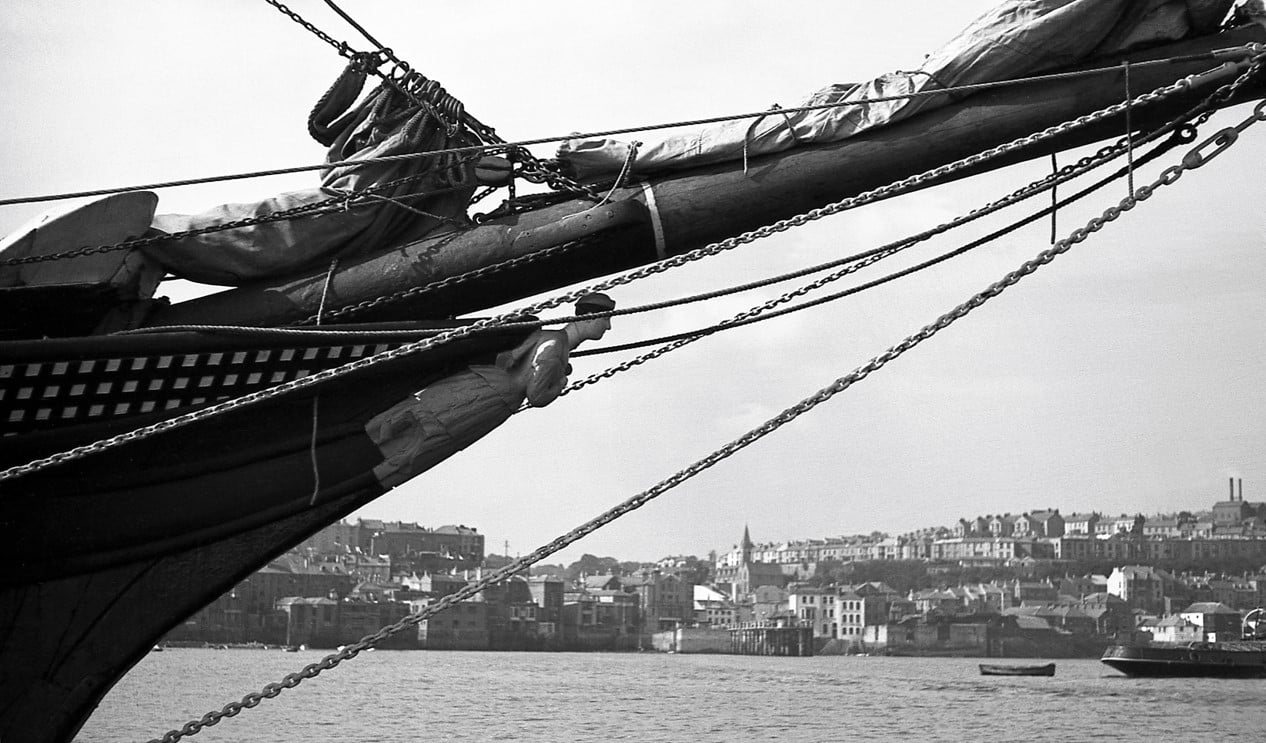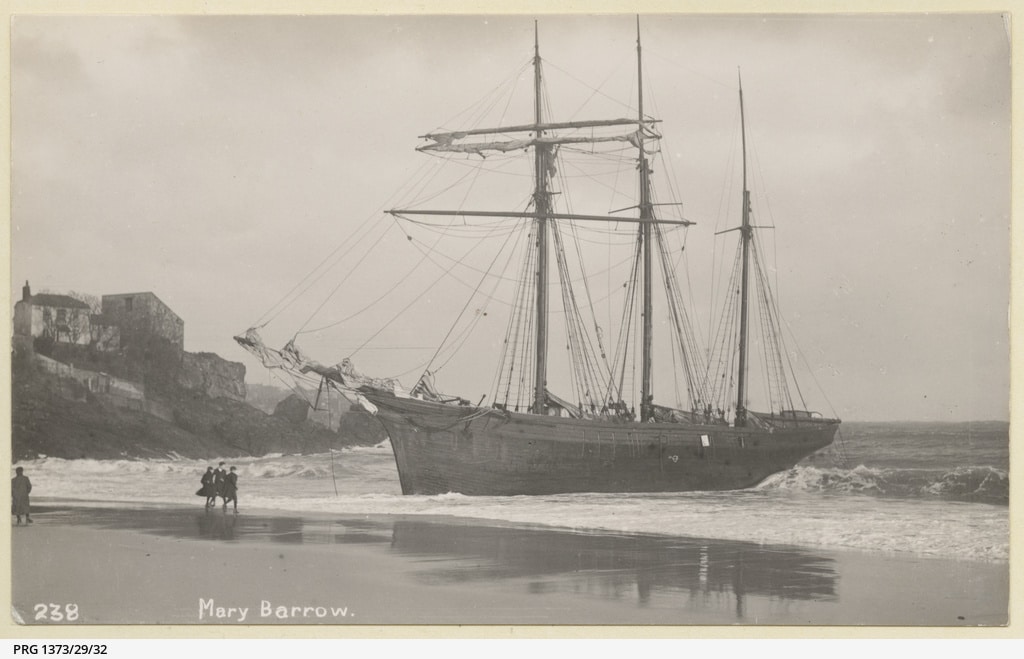

By Linda Batchelor
In a recent exhibition at National Maritime Museum Cornwall, entitled Memories of Falmouth 1934 – 1969, several images were featured of the schooner Mary Barrow. The three masted topsail schooner was one of the last sailing ships plying the coastal trade around Britain in the 1930s.
Falmouth built in 1891 and in later years frequently working out of Cornish ports, Mary Barrow was known as a hard-working ship carrying a variety of cargoes but also with a reputation of being one of the most beautiful in the trade.
The schooner was built by W H Lean at Falmouth and launched in October 1891. William Henry Lean was a successful ship and boatbuilder with a shipbuilding yard on the Bar at Falmouth. He lived at Armyn Villa, at Bar Road, close to his boatyard and he became Mayor of Falmouth in 1870. He was a well-established member of Falmouth society, a member of the Town Council, a Justice of the Peace and a keen yachtsman.
When built Mary Barrow was a wooden three masted 163-ton sailing ship equipped with a topgallant yard set over double topsails. In 1926 she was fitted with an engine and the topgallant was replaced by a triangular ‘raffee’ sail, but she avoided the fate of many schooners and retained a great deal of sail for such a vessel.

The Mary Barrow in Falmouth Harbour. The Weller Collection, NMMC.
The Mary Barrow was built in Falmouth for James Barrow, a shipowner in Barrow, where she was registered, and was intended for the South American trade in bone, bonemeal and hides. The first master was Captain James Crewdson of Ulverston who took delivery of the vessel in Falmouth and sailed her to the home port in Lancashire. Captain Crewdson had a long association with the schooner’s owner and had previously been master of another of his vessels the J H Barrow in 1881. This new schooner was probably named after the wife or daughter of the owner.
In keeping with the name of the vessel there was a carved figurehead of a woman beneath the bowsprit. It is unclear whether this decoration was added at the time of the build or later. The name of the carver is also unknown but the majority of ship’s figureheads were created by unknown craftsmen.
The use of marine figureheads has a long history and a figurehead was often seen as a visual representation of a ship and as a guiding spirit which offered protection for the crew. On British vessels both naval and merchant ships carried figureheads representing a wide range of subjects and on merchant ships they often represented a member of the owner’s family as was probably the case with the Mary Barrow. However as wooden ships declined so too did the use of a figurehead and by the end of the nineteenth century a figurehead such as that of the Mary Barrow was probably less common or even unusual at the time of building. The figurehead was to be one of the features that distinguished this lovely ship throughout her working career.

A view of the figurehead of the Mary Barrow in Falmouth Harbour taken on 16th September 1936. The Weller Collection, NMMC.
The ship was originally built for the trans Atlantic trade and although owned in Barrow, it would have had a close connection with Falmouth not only because of being built there but also as both her first and last port of call on the coast of Britain. The vessel’s trading life began with trips to South America, the Caribbean and Newfoundland. The trade with South America was for hides and bonemeal from Brazil and Uruguay and with Newfoundland for dried salted cod.
As the stock fish trade declined Mary Barrow became more involved with the domestic British coastal trade between ports in the North West such as Glasgow, Ayr and Runcorn and ports in the South West such as Penzance, Falmouth, Polperro, Par and Plymouth. The trade was in commodities such as coal and china clay.
In the early part of the twentieth century the vessel was still owned in Barrow but after the First World War ownership moved to Cornwall. In 1926 the vessel was managed by Couch of Fowey and in 1928 she was owned in Newquay. Around 1932, by then having been fitted with an auxiliary engine, she was sold to Captain Mads Peter Mortensen of Truro. Peter Mortenson was born in 1893 in Denmark and had served throughout his career at sea on British merchant ships to achieve his Master’s ticket. He had married and settled with his family in Truro and became well known as a skipper and for his eccentricities.
During storms in January 1908 Mary Barrow nearly came to grief when stranded on Porthminster beach in St Ives alongside the Lizzie R Wilce of Falmouth. About 9pm on 7th January the Lizzie R Wilce carrying anthracite from Swansea to St Malo was grounded on the beach. The crew were rescued by the lifeboat James Stevens No10. The following morning at 4.40am the lifeboat was called out again to the Mary Barrow which with a cargo of coal from Swansea for Cowes was also stranded on the beach. The crew were rescued and she was refloated on 14th January and able to continue the journey.

The Mary Barrow stranded on Porthminster Beach, St Ives, January 1908. State Library of South Australia.
The end for the schooner did not come, however, until September 1938 when she was owned by Captain Mortensen. The Mary Barrow was bound for Truro carrying 230 tons of coal when in dense fog on the Calf of Man she struck rocks. The crew were able to reach Port Erin in a small boat but the abandoned schooner was overtaken by a storm during the night and was completely destroyed.
A familiar sight on the Cornish coast was lost but several images of the schooner still remain to remind the viewer of the existence and the elegance of this lovely sailing vessel.
The Bartlett Blog is written and produced by the volunteers who staff The Bartlett Maritime Research Centre and Library of National Maritime Museum Cornwall. The Schooner Mary Barrow was written by Linda Batchelor. Notes on the Mary Barrow for the ‘Memories of Falmouth’ exhibition were contributed by Lynne Vosper
The Bartlett Library holds a Collection of over 20,000 volumes and offers access to one of the finest collections of maritime reference books, periodicals and archival material. The Bartlett Blog reflects the diversity of material available in The Bartlett Library.

National Maritime
Museum Cornwall Trust
Discovery Quay
Falmouth Cornwall
TR11 3QY
View Map
See our opening hours
Tel: +44(0)1326 313388
Email: enquiries@nmmc.co.uk